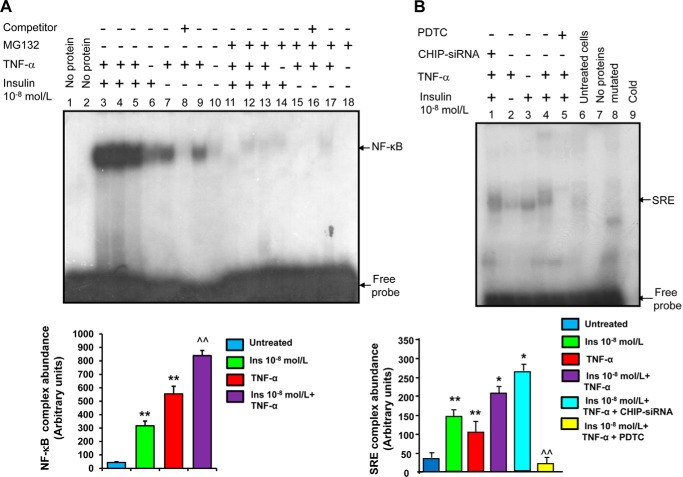FIGURE 5.
Co-Activation of NF-κB and myocardin/SRF in response to insulin. A, insulin induction of NF-κB in myoblasts exposed to TNF-α. EMSA was performed by mixing the 32P-oligonucleotide containing the NF-κB consensus sequence with nuclear proteins from canine cardiac myoblasts treated with insulin (10−8 mol/liter) for 16 h prior to TNF-α stimulation (10 ng/ml, added to cardiac myoblasts during the last 15 min of insulin treatment). A parallel set of cardiac myoblasts was pre-treated with the proteasome inhibitor MG132 (10 nmol/liter) for 6 h prior to insulin addition. The results of an EMSA with nuclear protein extracts from cardiac myoblasts treated with insulin with or without TNF-α (10 ng/ml) or TNF-α alone are shown. Specificity of the SRF-SRE complex formation was determined by competition with an unlabeled oligonucleotide. Results shown here are representative of three independent experiments. B, role of NF-κB in mediating the SRF-SRE binding activity in cardiac myoblasts treated with insulin and TNF-α. Canine cardiac myoblasts were transfected with a pool of three different CHIP siRNAs or a scrambled (scr) siRNA (negative control) and treated with insulin (10−8 mol/liter) 16 h prior to TNF-α stimulation (10 ng/ml, added to cardiac myoblasts during the last 15 min of insulin treatment). A parallel set of cardiac myoblasts was pre-treated with the NF-κB inhibitor PDTC for 6 h prior to insulin addition. Following treatments, nuclear extracts (10 μg) were incubated with or without 32P-end-labeled SRE oligonucleotides. Specificity of the SRF-SRE complex formation was determined by competition with a cold oligonucleotide and mutated labeled SRE oligonucleotides. Here shown is an EMSA representative of three independent experiments.

